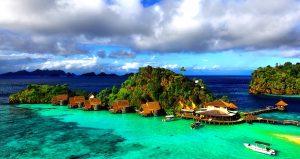
A weathered wooden pier juts from the alabaster shore on the isle of Mansuar—a jungled sliver of limestone in Raja Ampat, Indonesia—into the cyan sea, an unremarkable jumble of planks and pilings perched a few yards above the glassy surface. But just below it, the Yenbuba jetty—named for the island’s tiny village—morphs into an aquatic Xanadu, teeming with Technicolor and life. Countless fish painted in riots of pattern—teal parrotfish finned in lavender, fawn pufferfish spotted with white—dart among posts studded with Gorgonian sea fans, their lacelike fronds flitting in shades of amber, fuchsia, and tangerine. A panoply of other coral types—staghorn, elkhorn, pipe, brain—blanket the ocean floor, creating a rainbow-hued reefscape so varied and vivid it’s dizzying to behold.
Such kaleidoscopic submarine scenes are commonplace in Raja Ampat (“Four Kings”), a chain of some 1,500 islands strewn like jewels across 29,000 square miles off the west coast of West Papua province. Straddling the Pacific and Indian oceans and anchored by the four large islands for which it’s named, the archipelago makes up the heart of the Coral Triangle—the most biodiverse marine environment on earth. Home to 76% of the world’s coral species—over 550, compared with 70 in the Caribbean—and some 1,500 types of fish, it’s often called a “species factory” by scientists, thanks to its plethora of endemic organisms (more than 70 species of reef fish, coral, and crustaceans), a list that grows with every new discovery. Simply put, Raja Ampat remains one of the world’s last virtually untouched places and a bona fide Valhalla for scuba divers and snorkelers alike.
Credited to Fortune https://fortune.com/longform/raja-ampat-indonesia-yacht-luxury-vacations/
